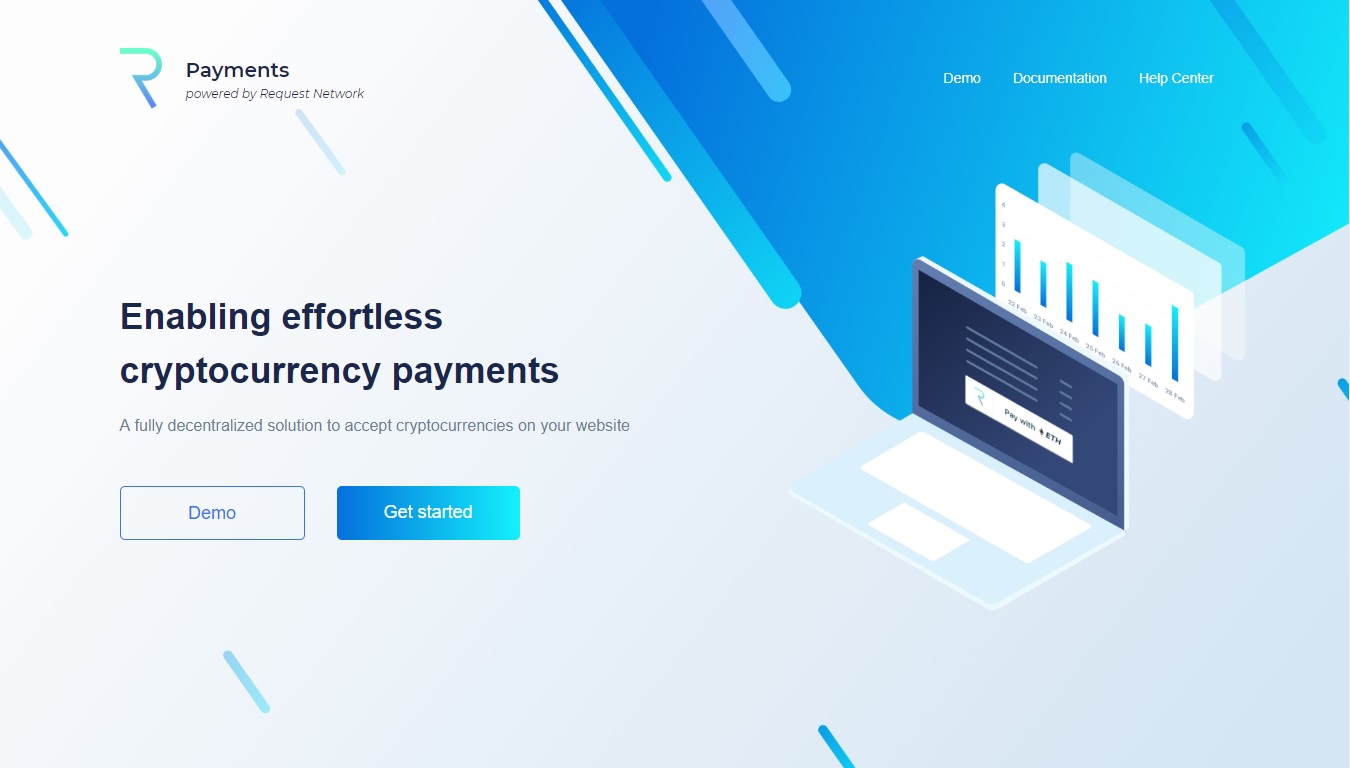Creating the “future of commerce” is a very challenging task, but that’s what Request Network has set out to do. The project is commonly referred to as “PayPal 2.0” or “PayPal for cryptocurrencies,” but it’s much more than that. Indeed, building the means by which commerce will be conducted in a rapidly digitizing world entails more than just creating a cryptocurrency payment mechanism.
The idea for Request Network was conceived in 2014, a result of the frustration its early members experienced with the sluggish process of bank-controlled international payments. This eventually coalesced around the idea of utilizing cryptocurrencies as a payment mechanism that would enable pain-free international transactions which, in turn, has grown to support further utilities.
The team marched towards building an outline of the early version of the product in the following 2 years. In 2017, it received the backing of the well-known startup incubator Ycombinator, which has previously aided Airbnb, Reddit, Coinbase, Quora and Women Who Code.
Much progress has been made since those early years. In early April 2018, Request’s mainnet beta was launched on the Ethereum network, with a “pay with Request” button to boot. This feature lets websites accept payments in cryptocurrency.
While the project has come a long way, there is much more to do if Request is to revolutionize commerce, and their roadmap confirms that. We’ll examine their 2017 accomplishments before diving into what they’ve managed so far in 2018 and what they hope to complete in the remainder of the year.
We’ve talked comprehensively about the project and its goal of making payments as simple as a matter of clicking once for a request, so we won’t go into detail about the ins-and-outs of the project here. If you’d like to learn more about the fundamentals of the project, read our guide to Request Network.
What Did Request Accomplish in 2017?
Buoyed by public support during the token launch, Request raced through the necessities of launching a website.
The first phase of their roadmap, called “Pyramid,” came to a close after the launch of both the token and website, and the finalization of the whitepaper. What followed was the “Colossus,” which diverted the team’s attention to building the foundation and actual services necessary for a cryptocurrency-based accounting and invoicing service.
Colossus was a vital step, the first generation of the Request product, and centered heavily on forming early partnerships and creating a viable product.

November 2017 saw the launch of “Continuous Payments,” an extremely useful feature for invoicing and other payment requests. This allowed requestors to be paid continuously – by the minute, day or hour – rather than in a lump sum at the end of a certain timeframe.
With progress in the early months ahead of schedule, the project was able to pull forward the “website interaction with Request” feature from Q1 2018 to Q4 2017. This allowed users to request and receive payments via a friendly interface on the website.

All of the priorities of the Colossus phase – the payee payment feature, continuous payments, and ecosystem growth – came to fruition with the launch of the platform on the Ethereum testnet in December 2017. Rather than just supporting invoicing, the team worked on developing their Request Core model to include support for salaries, loans, and donations.
Request’s Progress in 2018
2018 is a whole different ball game for Request, who have upped the ante to bring a completely usable payment system to firms and merchants.
Q1 2018 saw the team putting together the necessary features to ensure that the mainnet launch would operate successfully. This was guided by the thought of how they might be able to most effectively offer a payments service that negated the need for third parties, while supporting a variety of currencies.
In other words, convenience, comprehensiveness, and clarity in transactions were important pillars. The request has to be made simple for large-scale commercial adoption, tax management and real-time accounting should be utilized, and transactions must be made easily verifiable and disputable.
Q1 – Great Wall
The Q1 phase fell under the “Great Wall” phase. In a thoroughly detailed tech mind map that Request released, they describe their intentions to get developers onboard and build applications on top of the Request Network. We highly recommend reviewing this map, as it gives a clear sense of Request’s intentions. The possibilities for Request to be applied to various platforms is enormous, and includes websites, Virtual Reality, and IoT.
One of the most significant aspects of the Great Wall phase is the support for several cryptocurrencies – not just Ethereum, but other ERC-20 tokens and Bitcoin. Better still is the “Pay with Request” feature, which is a payment option that can be attached to websites, just like with PayPal or a debit/credit card. The documentation for developers to integrate this has also been released. A WordPress plugin has also been created by community member AdmREQ.
Partnerships and Other Notable Milestones
Security was also an important priority for the team, who ordered external audits of their contracts before the mainnet launch. It continues to be a priority as the the platform is polished and perfected over the rest of 2018.
Completing the list of tasks for the Great Wall phase was the growth of the ecosystem. To that end, Request sought out partnerships with accounting and auditing firms. A thriving ecosystem is essential for any project to take off – if there are no stakeholders, there is no potential for the coin or platform to grow in value.
Impressively, Request announced that they have partnered with PwC France to help clients bring blockchain services onboard their businesses. PwC is the second-biggest professional services firm in the world, and this collaboration with a regional unit is certainly a step in the right direction.
Request has also teamed up with Digix, a company that tokenizes assets and wants to bring actual gold onto the Ethereum blockchain. What this means for Request users is that they could have gold-backed Digix tokens (DGX) as an invoice option on Request (1 DGX token is backed by 1 gram of gold from the London Bullion Market Association).
Towards the end of April, they also announced partnerships with Wikimedia France, which will use Request to accept cryptocurrency donations. This is one of the first major nonprofits to begin accepting donations in cryptocurrency.
Other notable announcements and happenings include:
- The announcement of the Request Fund, which plans to allocate $30 million over 5 years to projects that will flesh out the Request Network
- Ledger wallet support for Request
- A partnership with RCN, a P2P global credit network, in which Request will act as the source of invoicing
- Listing on the Kyber Network DEX
- An AMA that covers the progress and future of Request
- The launch of a Bug Bounty program
These developments eventually culminated in the release of the mainnet at the end of Q1.
What Will the Rest of 2018 Bring?
The efforts of the other 3 quarters of 2018 will focus on privacy, larger coin support, further ecosystem growth, tax, auditing and payment extensions, governance systems, international payments, and the launch of an “Internet of Things” framework.
Q2 – Stonehenge
Request Network is extensively researching the application of zk-SNARKs for the purposes of privacy. They are keeping an eye on the progress of this privacy technology and are working on a proof of concept for the same. This is expected to be released in Q2. It would allow only the payer and payee to view the payment information.
Request would also like to organize discussions with institutions like the World Bank, the IMF, and the UN in Q2, but we have no word on this as of yet.
Other items on the agenda for Q2 are:
- Add management of fiat-currencies to Request (USD, EUR, CNY)
- Launching the “Request & Transparency” project, where they will work with city halls, associations, and governments to publish real-time information on their budget.
Q3 – Colosseum
Q3 is all about extensions and extending functionality on the network. Notable among these are an escrow extension to release funds upon the satisfaction of all service criteria and a real-time tax payment extension – particularly useful for those who freelance.
- Deploy the Down Payment extension to specify an amount to pay and a specific date on which to process it
- Deploy the Late Fees extension to specify penalties if a Business is not paid on time.
- Add a Reputation Off-Chain layer
Q4 – Petra
The last quarter showcases Request’s grand ambitions. We don’t have any details on the specific approach to goals, but given Request’s forthright approach so far, we can certainly expect to hear about it as Q2 and Q3 pass. The following is what is to be expected in Q4 and beyond:
- Deploy a governance system (Vote/Token Chat)
- Launch the “Internet of Things framework” project
- Deploy intercurrency settlement through REQ token to facilitate international payments
- Launch the “Continuous Payment” extension, which will act as a Down payment with an infinity of micro payments
Final Thoughts
It’s extremely clear that Request is working hard to become the essential cryptocurrency-based platform for invoice and payment-related service – and not at all in the same vein as Bitcoin. They are approaching this methodically and creating a strong foundation that will allow the network to serve a variety of industries and payment mechanisms.
What is particularly appreciable is the honest communication from the team about the status of the project. Updates are frequent and detailed. That the network is up and running is simply further proof that we have a legitimate project in front of us.
There appears to be great promise in Request Network’s goals for the second half of 2018. As more users and firms operate on the network, we may see a steady change towards this new form of payment service, and all stakeholders may become convinced of the benefits. That will be a key aspect to keep an eye on. Helping this transformation will be the inclusion of the aforementioned extensions and multi-currency support.
If all this clicks – and more websites utilize the payment feature as well – Request is primed for a critical role in the payment of salaries, invoices, and auditing in the years to come.

